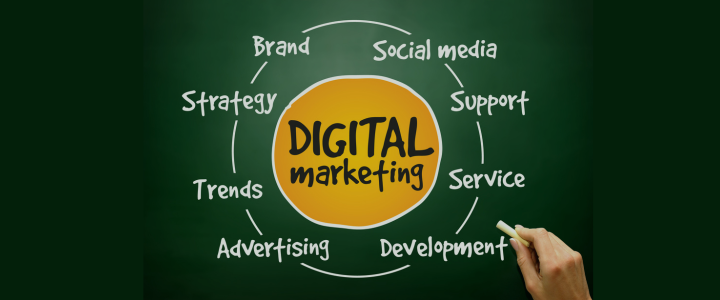As businesses journey through the fast-paced realm of digital marketing, staying ahead of emerging trends is paramount. This exploration unveils eight digital marketing trends poised to dominate in 2024, offering a glimpse into the strategies and technologies that will shape the future of online engagement and brand success.
1. Augmented Reality (AR) in Marketing: Transforming Experiences
Breaking Barriers Between Virtual and Reality
Augmented Reality (AR) is set to redefine how consumers interact with brands. This section explores the integration of AR in marketing strategies, creating immersive experiences that bridge the gap between the physical and digital worlds. From virtual try-on experiences in the fashion industry to interactive product demonstrations, AR is becoming a powerful tool for capturing audience attention and fostering engagement.
Applications of AR in Marketing:
- Virtual product try-ons for e-commerce.
- Location-based AR experiences for brick-and-mortar stores.
- AR-powered storytelling in advertising campaigns.
2. Voice Search Optimization: Conversations with Technology
Voice-Activated Future
With the rise of smart speakers and voice-activated devices, optimizing for voice search is no longer a choice but a necessity. This section delves into the impact of voice search on digital marketing strategies, emphasizing the need for businesses to adapt their content and SEO practices to align with the conversational nature of voice queries.
Strategies for Voice Search Optimization:
- Create natural, conversational content that mirrors how people speak.
- Optimize local search to cater to voice queries with local intent.
- Leverage long-tail keywords and FAQs to align with common voice search patterns.
3. Sustainability Marketing: Greening the Digital Message
From Ephemeral Trends to Lasting Impact
Sustainability is no longer just a buzzword; it's a driving force shaping consumer preferences. This section explores how businesses are integrating sustainability into their digital marketing strategies, resonating with environmentally conscious audiences. From eco-friendly product campaigns to transparent supply chain communications, sustainability marketing is fostering brand loyalty and goodwill.
Components of Sustainable Marketing:
- Communicate eco-friendly practices and initiatives transparently.
- Showcase sustainable product packaging and practices.
- Collaborate with influencers and organizations aligned with sustainable values.
4. AI-Driven Personalization: Tailoring Experiences with Precision
The Rise of Hyper-Personalization
Artificial Intelligence (AI) continues to redefine personalization in digital marketing. This section explores how AI algorithms are analyzing vast amounts of user data to deliver hyper-personalized experiences. From personalized product recommendations to individualized email campaigns, AI-driven personalization is enhancing customer engagement and conversion rates.
Implementing AI-Driven Personalization:
- Utilize machine learning for predictive analytics on user behavior.
- Dynamically adjust website content based on real-time user interactions.
- Craft personalized email campaigns with AI-driven segmentation.
5. Video Content Dominance: Capturing Audiences Visually
Visual Storytelling Takes Center Stage
The demand for video content is skyrocketing, and businesses are responding by making it a cornerstone of their digital strategies. This section explores the dominance of video in digital marketing, from short-form content on social media to long-form storytelling on branded platforms. Video's ability to convey emotions and messages swiftly makes it an indispensable tool for brands looking to connect with their audience on a deeper level.
Strategies for Effective Video Marketing:
- Leverage short-form videos on platforms like TikTok and Instagram Reels.
- Invest in high-quality, engaging storytelling for longer video formats.
- Implement interactive video elements for enhanced user engagement.
6. Influencer Marketing Evolution: From Macro to Micro
The Power of Authentic Connections
Influencer marketing continues to be a formidable strategy, but its landscape is evolving. This section explores the shift from macro to micro-influencers, emphasizing the power of authenticity and niche influence. Micro-influencers, with their smaller but highly engaged audiences, are becoming key partners for brands seeking genuine connections with consumers.
Approaches to Micro-Influencer Collaboration:
- Identify influencers aligned with niche interests relevant to the brand.
- Foster long-term relationships with micro-influencers for authentic content.
- Encourage user-generated content through micro-influencer campaigns.
7. Interactive Content Engagement: Beyond Passive Consumption
Turning Audiences into Participants
The era of passive content consumption is waning, and interactive content is taking center stage. This section explores the rise of quizzes, polls, and interactive storytelling in digital marketing. By turning audiences into active participants, brands can enhance engagement, gather valuable insights, and create memorable experiences that resonate.
Types of Interactive Content:
- Quizzes and polls for audience engagement.
- Augmented reality experiences for product interaction.
- Interactive storytelling through choose-your-own-adventure formats.
8. Social Commerce Integration: Seamless Shopping in Social Spaces
Transforming Social Platforms into Marketplaces
The intersection of social media and e-commerce is evolving into a seamless shopping experience. This section delves into the integration of social commerce into digital marketing strategies, allowing users to discover, explore, and purchase products without leaving their favorite social platforms.
Strategies for Social Commerce:
- Implement shoppable posts and product tags on social platforms.
- Leverage live shopping events for real-time interactions.
- Integrate user-generated content to enhance authenticity.
9. Micro-Moments Optimization: Capturing Instant Intent
Seizing the Blink-and-Go Opportunities
Micro-moments, those fleeting instances when consumers turn to their devices to solve an immediate need, are gaining prominence. This section explores the optimization of marketing strategies to address these micro-moments, ensuring that brands are present and relevant in those crucial seconds when decisions are made.
Strategies for Micro-Moments Optimization:
- Understand user intent in different micro-moments.
- Tailor content to provide quick solutions or information.
- Utilize location-based targeting for real-time relevance.
10. Data Privacy-Centric Marketing: Building Trust in the Digital Era
Respecting User Privacy in Every Interaction
As concerns about data privacy grow, businesses are shifting towards transparent and ethical data practices. This section delves into the importance of data privacy-centric marketing, emphasizing the need for businesses to build trust by respecting user privacy and implementing robust data protection measures.
Best Practices for Data Privacy-Centric Marketing:
- Clearly communicate data usage policies to users.
- Implement secure data storage and transmission protocols.
- Comply with evolving data protection regulations.
11. Gamification Strategies: Turning Engagement into Play
Transforming Brand Interaction into Games
Gamification is emerging as a powerful tool to enhance user engagement. This section explores how brands are incorporating game-like elements into their digital strategies, turning mundane interactions into enjoyable and rewarding experiences for their audience.
Elements of Successful Gamification:
- Introduce rewards, badges, or points for user participation.
- Create interactive challenges and quizzes to drive engagement.
- Use gamification to educate and motivate users in a playful manner.
12. Social Media Communities: Fostering Digital Tribes
Building Stronger Connections Beyond Platforms
Social media is evolving beyond mere platforms; it's becoming a space for communities to thrive. This section delves into the trend of building and nurturing social media communities, where brands can create digital tribes centered around shared interests, values, or experiences.
Strategies for Building Social Media Communities:
- Facilitate discussions and interactions within the community.
- Encourage user-generated content and participation.
- Provide exclusive content or perks for community members.
13. Visual Search Integration: Point, Snap, Discover
Revolutionizing Search with Images
Visual search is reshaping how users discover products and information. This section explores the integration of visual search in digital marketing, allowing users to search and explore using images rather than text. From fashion to home decor, visual search is enhancing the user experience by making searches more intuitive.
Implementing Visual Search Strategies:
- Optimize product images with descriptive alt text.
- Integrate visual search functionality on e-commerce platforms.
- Provide related product recommendations based on visual search queries.
14. Employee Advocacy Programs: Harnessing Internal Influence
Turning Employees into Brand Ambassadors
Employee advocacy programs are gaining traction as businesses recognize the power of internal influencers. This section explores how companies are leveraging their workforce to amplify brand messages, foster authenticity, and connect with audiences on a more personal level.
Steps to Implement Employee Advocacy Programs:
- Provide training and resources for employees to become advocates.
- Encourage employees to share company culture and behind-the-scenes content.
- Recognize and reward employees for their advocacy efforts.
15. 3D and Immersive Content: Stepping into Virtual Realms
Enhancing Engagement with Immersive Experiences
The rise of 3D and immersive content is transforming digital marketing into a more interactive and engaging space. This section explores how businesses are incorporating virtual and augmented reality to create immersive experiences that captivate audiences in ways traditional content cannot.
Applications of 3D and Immersive Content:
- Develop virtual showrooms for products and services.
- Create immersive storytelling experiences through VR and AR.
- Enhance user engagement with interactive 3D elements in marketing content.
Conclusion: Navigating the Dynamic Digital Horizon in 2024
This comprehensive exploration of 15 digital marketing trends for 2024 has unveiled strategies and technologies that will shape the future of online engagement and brand success. As businesses navigate the dynamic digital horizon, embracing these trends becomes not just a strategy but a commitment to staying at the forefront of innovation, engaging with audiences authentically, and navigating the ever-evolving currents of the digital landscape. In 2024 and beyond, these trends will serve as beacons guiding businesses toward digital excellence and unparalleled success
Written by Sulaiman Ahamed



